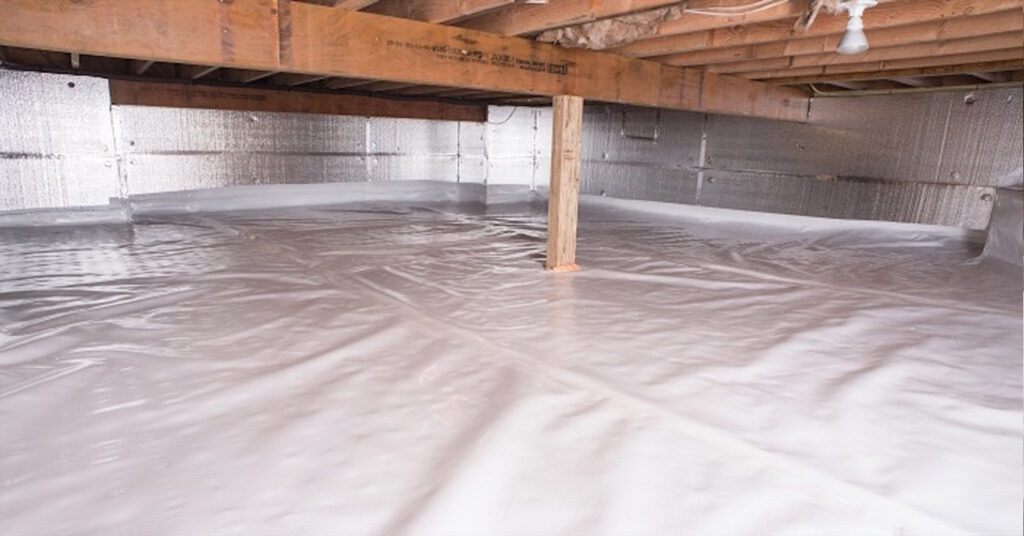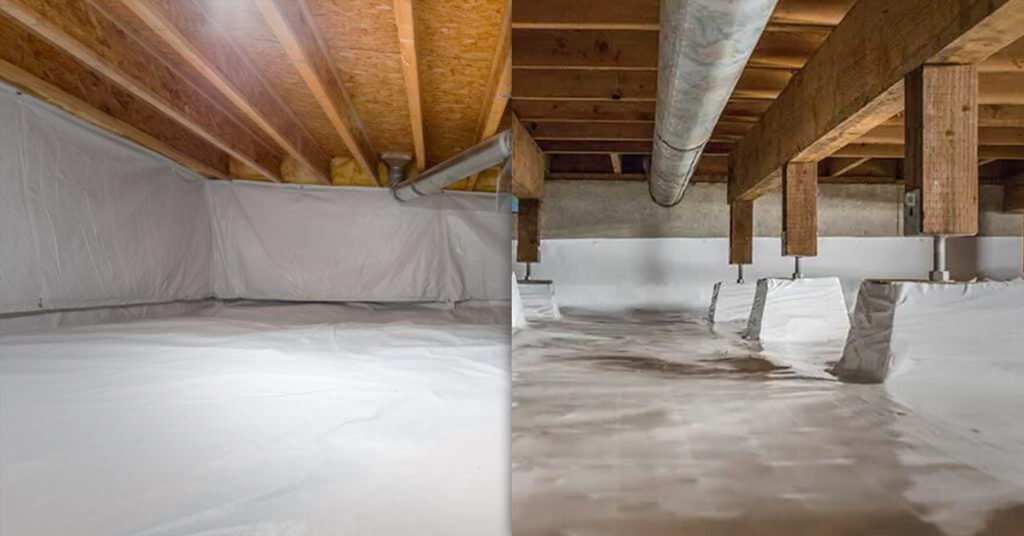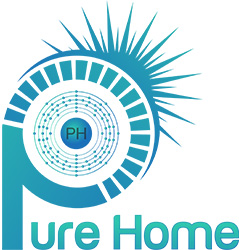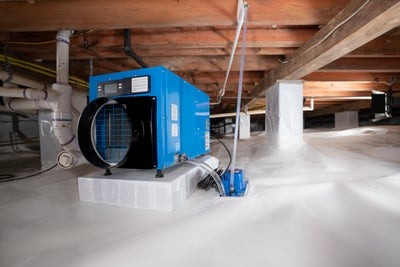Understanding The Basics of Crawl Space Insulation
Crawl space insulation is a critical component of maintaining energy efficiency and indoor air quality in homes.
We will discuss what crawl space insulation is, its importance, the different types available, how to choose the right insulation, the benefits it offers, and proper installation techniques.
Stay tuned to learn all you need to know about crawl space insulation as well as crawl space mold remediation.
Key Takeaways:
- Understanding the basics of crawl space insulation is essential for maintaining a comfortable and energy-efficient home.
- Proper crawl space insulation can improve energy efficiency, indoor air quality, and protect against moisture and mold.
- When choosing and installing crawl space insulation, be sure to consider climate, crawl space conditions, and budget for the best results.
What is Crawl Space Insulation?
Crawl space insulation refers to the material used to maintain temperature control and protect properties from environmental factors. It is crucial for areas like Duvall, Renton, Kent, and Tacoma where climate variations are common.
By acting as a barrier against moisture, cold drafts, and heat loss, crawl space insulation helps to stabilize indoor temperatures, reduce energy costs, and prevent damage caused by mold and dampness.
In these areas, proper insulation can also contribute to the longevity and structural integrity of buildings by protecting them from the harsh outdoor elements.
What are the Different Types of Crawl Space Insulation?

Various types of crawl space insulation include Fiberglass Insulation, Spray Foam Insulation, Rigid Foam Insulation, and Cellulose Insulation.
Each type of insulation has its own advantages.
- Fiberglass Insulation is cost-effective, easy to install, and provides decent thermal performance.
- Spray Foam Insulation offers superior air sealing properties and can fill tight spaces efficiently.
- Rigid Foam Insulation is moisture-resistant, provides high R-value, and can also act as a barrier against pests.
- Cellulose Insulation is eco-friendly, made from recycled materials, and excellent for soundproofing.
Fiberglass Insulation
Fiberglass insulation is a popular choice known for its thermal properties and affordability.
In terms of insulation capabilities, fiberglass is highly effective in trapping heat due to its composition of very fine glass fibers. This material creates numerous tiny air pockets that slow down the transfer of heat, making it an excellent thermal insulator. Fiberglass insulation is non-combustible, making it a safe option for crawl spaces where fire hazards need to be minimized.
One of the main reasons why fiberglass insulation stands out for crawl space projects is its versatility and adaptability. It can be easily installed in tight spaces and conforms well to irregular surfaces, ensuring comprehensive coverage. Its resistance to moisture also prevents mold and mildew growth, crucial for maintaining a healthy environment underneath a building.
Spray Foam Insulation
Spray Foam Insulation offers a seamless installation process and exceptional sealing properties.
When considering crawl space projects, the advantages of Spray Foam Insulation become evident. Not only does it provide a tight seal, reducing air leakage and energy costs, but it also acts as a moisture barrier, preventing mold and mildew growth. Due to its expansive nature, it fills gaps and crevices, creating a continuous barrier against heat loss and drafts. This form of insulation contributes significantly to maintaining consistent temperatures within crawl spaces, ultimately enhancing energy efficiency and indoor comfort levels.
Rigid Foam Insulation
Rigid Foam Insulation is valued for its durability and resistance to moisture.
When considering insulation options for crawl spaces, the durability and moisture resistance of Rigid Foam Insulation are key factors to take into account. Its robust structure ensures that it can withstand the rigors of varying temperatures and moisture levels over time. The moisture-resistant properties of this type of insulation prevent the growth of mold and mildew, making it an ideal choice for damp environments such as crawl spaces.
Cellulose Insulation
Cellulose Insulation is known for being eco-friendly and offering excellent thermal performance.
Exploring the sustainable aspects and thermal efficiency of Cellulose Insulation reveals its remarkable capability to enhance thermal comfort while minimizing environmental impact in crawl spaces. This type of insulation is made from recycled paper materials, making it a renewable and resource-efficient choice for insulation projects. Cellulose Insulation has the ability to effectively regulate indoor temperatures, keeping crawl spaces cool in the summer and warm in the winter. Its natural composition also contributes to improved air quality by reducing the presence of allergens and pollutants.
How to Choose the Right Insulation for Your Crawl Space?

Selecting the appropriate crawl space insulation involves considering factors like climate conditions, the state of the crawl space, and your budget. Residents of Woodinville and Steilacoom can benefit from tailored insulation choices.
When evaluating insulation options, it’s essential to first understand the specific climatic conditions of the region. This includes the typical temperature ranges, humidity levels, and overall weather patterns. Different insulating materials perform differently depending on whether you’re dealing with a cold, wet climate like Woodinville or a more moderate one like Steilacoom.
Next, examining the state of your crawl space is crucial. Factors such as moisture levels, existing insulation, and any potential pest or mold issues should all be taken into account. Each of these elements will impact the effectiveness and longevity of the chosen insulation solution.
But perhaps most importantly for many residents, is the consideration of financial constraints. It’s essential to strike a balance between selecting high-quality insulation that meets your needs and doesn’t exceed your budget. Customized options, tailored to the unique requirements of Woodinville and Steilacoom dwellers, can offer the best of both worlds in terms of performance and cost-effectiveness.
Consider the Climate
When choosing crawl space insulation, it is vital to consider the climate of the region to ensure optimal thermal regulation. Understanding how insulation responds to temperature fluctuations is key to making the right choice.
Climate plays a significant role in the effectiveness of insulation in maintaining a comfortable indoor environment. For instance, in colder climates, insulation needs to be able to resist heat transfer from the warm interior to the cold exterior efficiently.
Proper insulation can help prevent energy loss and reduce heating costs during the winter months. On the other hand, in warmer climates, insulation should focus on minimizing heat gain to keep the interior cool. Choosing the right type of insulation that aligns with the local weather conditions can lead to long-term energy savings and enhanced comfort.
Evaluate the Condition of Your Crawl Space
Assessing the condition of your crawl space, including factors like moisture levels and ventilation, is essential for determining the most suitable insulation solution. Proper evaluation ensures effective insulation performance.
Moisture control plays a crucial role in preserving the structural integrity of your home. Excessive moisture can lead to mold growth, wood rot, and musty odors if left unchecked. By assessing the ventilation in your crawl space, you can regulate humidity levels and prevent these damaging effects.
A comprehensive inspection will also reveal any existing issues that need to be addressed before installing insulation, ensuring a long-lasting and energy-efficient solution. Selecting the right type of insulation based on the specific conditions of your crawl space is vital for improving indoor air quality and reducing energy costs.
Determine Your Budget
Establishing a budget for crawl space insulation allows individuals to explore various options without compromising on quality.
One important aspect of optimizing the investment in insulation is to consider the long-term benefits of energy savings and improved comfort levels.
By strategically allocating funds towards quality insulation materials and professional installation services, homeowners can ensure durability and effectiveness in the long run.
In terms of crawl spaces, cost-effective solutions like sealing air leaks, insulating ductwork, and using reflective insulation can make a significant difference in maintaining a comfortable indoor environment without breaking the bank.
What Are the Benefits of Proper Crawl Space Insulation?
Proper crawl space insulation offers a range of benefits, including improved energy efficiency, enhanced indoor air quality, protection against moisture-related issues like mold, and a boost in property value.
Effective crawl space insulation not only helps in reducing energy costs by creating a thermal barrier that prevents heat loss or gain, but it also leads to increased comfort levels in the property. By controlling the temperature fluctuations, the insulation plays a crucial role in maintaining a consistent and pleasant indoor environment. By minimizing the intrusion of outdoor pollutants and allergens, it contributes to a healthier living space. Another notable advantage is the prevention of moisture build-up which can lead to structural damage and health hazards.
Improved Energy Efficiency
Efficient crawl space insulation contributes to improved energy efficiency, resulting in significant cost savings on heating bills. Understanding the role of insulation in energy conservation is crucial for homeowners seeking to reduce energy expenses.
Insulation acts as a barrier that helps keep the desired temperature constant in a property by trapping heat during colder months and repelling it during warmer periods. By minimizing heat transfer through walls, floors, and ceilings, insulation reduces the workload on heating systems, leading to lower energy consumption and ultimately lower utility costs. Proper insulation can create a more comfortable indoor environment, as it helps maintain consistent temperatures throughout the living spaces.
Better Indoor Air Quality
Quality crawl space insulation promotes better indoor air quality by preventing the infiltration of pollutants and ensuring proper ventilation. Addressing air quality concerns through insulation leads to a healthier living environment.
When insulation is installed correctly, it acts as a barrier that traps pollutants and prevents them from circulating in the indoor air. The encapsulated space created by effective insulation helps in reducing the presence of allergens and pollutants that can contribute to respiratory issues and other health problems.
Proper ventilation is a crucial component that works hand in hand with insulation to maintain a clean indoor environment. It allows for fresh air exchanges, preventing stagnation and build-up of harmful substances within the living space.
Protection Against Moisture and Mold
Effective crawl space insulation acts as a barrier against moisture infiltration and mold growth, contributing to a healthier living environment.
Insulation not only helps in maintaining comfortable indoor temperatures but also plays a vital role in safeguarding your home against unwanted dampness and potential mold development. By creating a protective shield around your living space, insulation acts as a shield that deflects excess moisture, thereby reducing the risk of mold formation.
Humidity control is paramount in mold prevention, as damp conditions provide fertile ground for mold to thrive. Properly installed insulation aids in regulating humidity levels, keeping them within the recommended range to deter mold growth.
Particularly in crawl spaces, where moisture seepage is common, insulation serves as a crucial moisture barrier that not only keeps the area warm but also helps in preventing excess dampness that could lead to mold outbreaks. By addressing humidity issues through effective insulation, homeowners can create a healthy and mold-resistant environment within their crawl spaces.
Increased Home Value
Installing proper crawl space insulation can increase the value of your home, contributing to property appreciation in the competitive real estate market.
Homeowners often overlook the significance of crawl space insulation in enhancing their property’s worth. A well-insulated crawl space not only improves energy efficiency but also prevents issues like mold, moisture, and pest infestation, crucial for maintaining a healthy living environment.
Investing in quality insulation is an investment in the longevity and sustainability of your home. It not only adds to the overall comfort and durability of the property but also attracts potential buyers willing to pay a premium for a well-maintained and energy-efficient home.
How to Install Crawl Space Insulation?
The installation of crawl space insulation involves preparing the space, selecting suitable materials, ensuring proper installation, and sealing any gaps or cracks. Following these steps ensures effective insulation and temperature control.
Preparation is key when it comes to insulating your crawl space. Begin by cleaning out any debris or clutter from the area to create a clean workspace. Next, inspect the space for any existing moisture issues and address them before proceeding with insulation. Choosing the right materials is crucial for long-lasting insulation. Opt for materials that are durable, moisture-resistant, and provide a high R-value to maximize energy efficiency.
- In terms of installation techniques, start by laying down a vapor barrier to protect against moisture infiltration. Secure the insulation properly, ensuring a tight fit to eliminate any gaps that can compromise its effectiveness. Consider using insulation hangers or supports to keep the insulation in place.
- Sealing any gaps or cracks is the final step in ensuring a well-insulated crawl space. Use caulk or foam insulation to seal off any openings where air could leak in or out. This final touch helps maintain the desired temperature and prevents energy loss.
Prepare the Crawl Space
Preparing the crawl space for insulation entails cleaning the area, ensuring proper ventilation, and conducting a thorough inspection for potential issues. Proper preparation sets the stage for successful insulation installation.
Start by removing any debris and clutter from the crawl space to create a clean and clear working environment. Next, focus on ensuring adequate ventilation by installing vents or fans to promote air circulation and prevent moisture buildup. Schedule a detailed inspection to identify any structural concerns, pests, or mold that could impact the insulation process. Addressing these issues beforehand will help you avoid complications during and after installation. Taking these steps will ensure that your crawl space is properly prepped and ready for insulation.”
Choose the Right Insulation Material
Selecting the appropriate insulation material involves considering factors like thermal resistance, moisture protection, and installation suitability. Choosing the right insulation material is crucial for long-term performance.
When evaluating insulation materials for crawl spaces, thermal resistance is a key factor to keep in mind. This property, often referred to as R-value, indicates the material’s ability to resist heat transfer. The higher the R-value, the better the insulation’s ability to prevent heat loss or gain.
Moreover, moisture protection is essential to prevent issues like mold and mildew growth, which can compromise indoor air quality. Ensuring that the insulation material has moisture-resistant properties will help maintain a healthy environment.
Install the Insulation Properly
Proper installation of crawl space insulation requires precise techniques, attention to detail, and may benefit from professional assistance. Ensuring accurate installation is essential for optimal insulation performance.
When installing crawl space insulation, it is crucial to start by cleaning the area thoroughly to remove any obstructions or debris that could affect the insulation’s effectiveness. Next, measuring and cutting the insulation materials to fit snugly into the space is key for achieving maximum coverage. Sealing any gaps or cracks in the walls and floors before placing the insulation can prevent air leakage and improve energy efficiency.
Seal Any Gaps or Cracks
Sealing any gaps or cracks in the crawl space is crucial to maintaining an airtight environment and optimizing energy efficiency. Addressing gaps and cracks enhances the overall insulation effectiveness.
When gaps and cracks are left unsealed in the crawl space, it can lead to issues such as air leakage, moisture intrusion, and energy loss.
This not only affects the comfort levels inside your home but also puts a strain on your heating and cooling systems, resulting in higher energy bills. By sealing these openings, you create a barrier that prevents conditioned air from escaping and outside air from infiltrating.
Proper insulation not only keeps your indoor temperatures consistent but also reduces the workload on your HVAC system, extending its lifespan and lowering your utility costs in the long run.
Frequently Asked Questions about The Basics of Crawl Space Insulation
What is crawl space insulation and why is it important?
Crawl space insulation refers to the material used to prevent heat loss or gain in the crawl space of a building. It is important because a poorly insulated crawl space can result in higher energy bills and reduced comfort in the living space above.
What are the benefits of insulating my crawl space?
Proper crawl space insulation can lead to improved energy efficiency, lower utility bills, better indoor air quality, and increased comfort in your home. It can also help prevent moisture and mold issues.
What types of insulation can be used in a crawl space?
There are a few options for crawl space insulation, including fiberglass batts, spray foam, and rigid foam boards. The best type for your crawl space will depend on factors such as budget, moisture levels, and accessibility.
How do I know if my crawl space needs insulation?
If your floors feel cold in the winter or your energy bills are higher than usual, it may be a sign that your crawl space needs insulation. You can also check for drafts or moisture in the crawl space, which can indicate a lack of proper insulation.
Can I install crawl space insulation myself?
While it is possible to install crawl space insulation yourself, it is often best to hire a professional. Installing insulation requires specialized knowledge and equipment, and mistakes can lead to reduced effectiveness and potential safety hazards.
How often should I replace crawl space insulation?
The lifespan of crawl space insulation can vary depending on factors such as type of insulation, climate, and moisture levels. However, as a general rule, it is recommended to replace insulation every 15-20 years to maintain its effectiveness.



